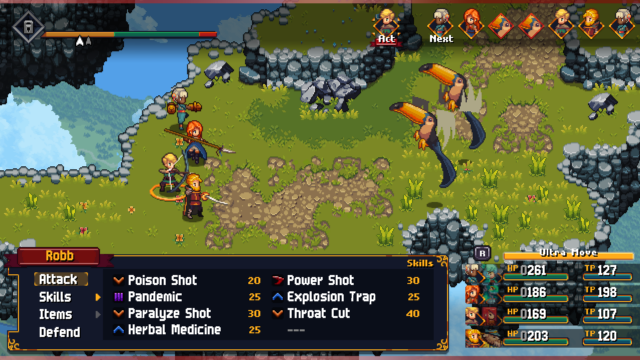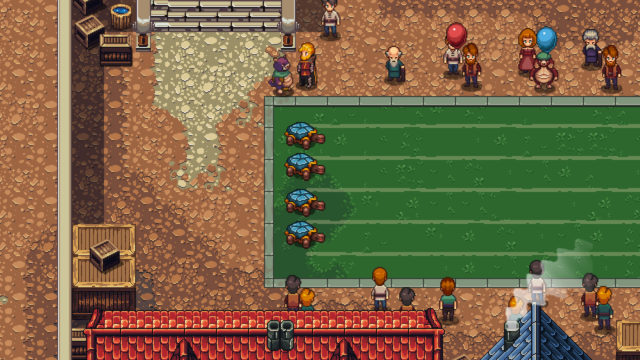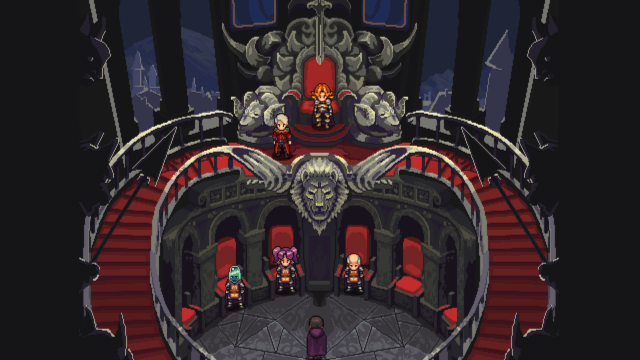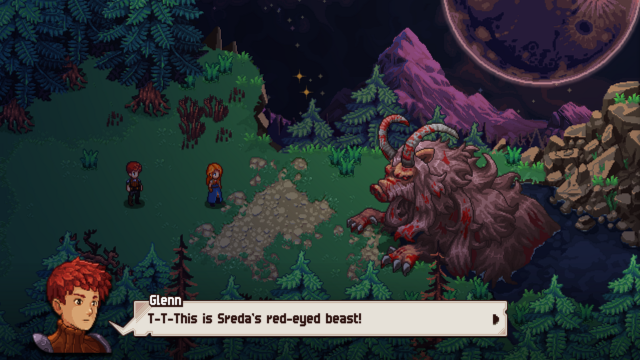Chained Echoes Review
Echoes of Greatness
Chained Echoes is a game that effortlessly evokes superlatives. It lovingly embraces its 16-bit JRPG inspirations while never feeling derivative in the slightest. It successfully sets out to reinvigorate the well-worn turn-based combat formula found in many games of that era while adding many smart and well-considered elements to the mix, ultimately creating a bold and involving combat experience that feels classic and fresh at the same time. A crisp pixel-art style and stellar musical compositions wow the eye and ear as it weaves an involved and lengthy narrative full of twists and turns. In short, developer Matthias Linda has tapped into a very specific niche, setting a high-water mark of quality in the process.
Chained Echoes takes place on the war-torn continent of Valandis, a place constantly embroiled in conflicts between its three dominant kingdoms. War has been a way of life for its citizens for hundreds of years, with entire generations living and dying never knowing any other way of life. The game follows an ensemble cast of characters of various fantasy races from all over the continent, brought together for various reasons but ultimately looking for a way to bring the constant hostilities to an end.
The game’s intro chapter sees Glenn and Kylian, two capable Sky Armor pilots — this game’s version of flight-enabled mechas — who have joined a band of mercenaries on a mission behind enemy lines to help reclaim the recently invaded city of Wyrnshire. They get far more than they bargained for, however, as they unwittingly cause a calamitous explosion, killing thousands and kicking off the game’s chain of events. The next forty to fifty hours see interested parties from all corners of Valandis chase after the grand grimoire, the small unassuming stone that caused the disaster in Wyrnshire, in order to win the war, as Glenn and Kylian, having survived the explosion, find themselves criss-crossing the land, entangled in a web of machinations and joined by an ever-growing retinue.
For its considerable length, the game’s narrative is paced exceedingly well. There are rarely any stretches of time that don’t feature at least a couple of interesting story beats, with just about all party members receiving their fair share of growth and screentime. That’s not to mention a satisfying rogue’s gallery of villains, ever scheming new plots and machinations for the heroes to foil. Even as new heroes and villains continue to be added to the cast until fairly late in the game, including some optional party members, the narrative continues to grow and evolve in intriguing, if not wholly bombastic, ways. The writing is well-considered, filled with charm and humor, and plenty of twists and turns along the way.
Equally as impressive as the story is the game’s combat system, particularly in how it manages to take the often-copy-and-pasted turn-based combat basics and innovates on them rather than simply iterating. It takes almost zero effort to come to grips with the ground-level basics: turn order is displayed on-screen, while characters have standard combat options such as attack, defend, skills, and items. What stands out is how more nuanced systems are steadily introduced, not replacing the familiar core combat options but subtly nudging them to new heights.
Take, for example, character skills. Chained Echoes treats the term “skills” as a catch-all that incorporates special physical attacks, magical spells, healing abilities, and more. Each of these skills falls into one of six families, which coincide with the combat overdrive gauge. The on-screen overdrive gauge indicator moves left and right along it depending on the actions characters and enemies take. As long as the indicator remains in the neutral zone, damage taken and received is at standard levels. Pushing the indicator into the green “sweet spot” zone raises the party’s offense and defense levels, but becoming careless will push the indicator past the green zone and into the red, giving enemies the upper hand.
As combat plays out, the gauge displays a random skill type; while most skill families will inch the indicator toward the dreaded danger zone, using a skill of the displayed type actually lowers it. This seemingly small tweak adds a surprisingly deep layer of strategy to what is usually a taken-for-granted combat system. Moment-to-moment decision making may see players forego a devastating attack in favor of something less damaging that will lower the gauge instead, or risk entering the red zone with enemy turns coming up in order to cast that last-ditch healing spell. It’s a supremely engrossing juggling act that ensures combat never becomes rote and dry. In short, there are a great deal more tactics baked into this battle system than one might find in a dedicated tactical RPG.
There are still further ways in which the combat system innovates, and the game continues to introduce new twists long after it’s begun. Up to eight characters can be placed in the combat party, paired in four groups of two, with the four actively participating in battle able to tag in or out with their partner at will. The Sky Armors introduced in the opening sequence return later on and provide additional options for both overworld traversal and combat against enemy powerhouses. All of these options come to fruition in the game’s many required and optional boss battles, which often feature further gimmicks to contend with. It’s a good thing, then, that the game is relatively forgiving to those who fall in combat or barely scrape by at the last minute: fleeing from normal battles is a given, the party is automatically rejuvenated after every battle, and a failed battle can simply be reattempted without penalty.

Staying in the green “sweet spot” of the overdrive gauge can be quite a fun yet stressful juggling act.
None of that is to say that this is an easy game. In fact, Chained Echoes is deceptively hard; even with the use of Sky Armor mechas and an overdrive gauge to give one an edge in battle, enemies tend to hit hard and are quite spongy. A group of them can quickly wipe out the entire battle party, and even just two or three together can make for some edge-of-the-seat moments. This is coupled with the fact that defeating enemies does not net the player any experience points in the traditional sense; rather, victorious characters gain a resource called SP, which can be used to slowly strengthen their combat abilities. Before they can be upgraded, however, new abilities must first be learned. This requires the use of grimoire shards, which are only earned through boss encounters and can be exchanged for one permanent new skill, stat buff, or passive ability per character. To mitigate the game’s challenge, a handful of unorthodox adjustable settings are included in the options menu, such as the ability to lower enemy stats or widen the overdrive gauge’s safe zone.
As if the engrossing narrative and tactical combat system weren’t already evidence enough of outstanding game design, Chained Echoes also offers its players plenty to do between the lines. Though many of these activities aren’t immediately available and have to be naturally unlocked by progressing through the story, they ensure that the game’s latter half offers plenty of breathing room for those who want it. Revisiting earlier areas becomes available early on via waypoint crystals, and an airship eventually allows for travel to yet-undiscovered locations, where more sidequests may be found. In a move clearly inspired by the Suikoden series, the party eventually attains an island stronghold and can travel the world recruiting new non-playable clan members to join their ranks and populate their stronghold. A reward board provides challenges to accomplish in each of the game’s areas, and joining the Adventurer’s Guild offers rewards for tracking down and felling special rare beasts. Suffice to say, there’s lots to do to set the completionist heart aflutter.

There’s no shortage of side activities to give the story a little breathing room in the game’s latter half.
It certainly doesn’t hurt that the game also looks and sounds amazing. The 16-bit art style is used to great effect here. The world is vibrant and laid out in an engaging manner. The large cast of characters are all distinct, sometimes quite imaginative, and well animated to convey emotion. Large, crisp character portraits during dialogue play a considerable part in this as well. True to form, there is no voice acting in the game, but the soundtrack is outstanding. Each location has a distinct musical theme that easily gets the player humming along during exploration, with high-energy tracks playing while in a bustling market town or to give a frantic edge to combat. On the other end of the spectrum, the soundtrack can dip into moody atmosphere when the game calls for it, or just slow things down and sound pretty. There’s even a bit of humor when a turtle race is hilariously accompanied by a snippet of ultra-heavy thrash metal. Compared to the best soundtracks of the 16-bit era, Chained Echoes can effortlessly and proudly hold its own.
It’d be easy to simply compare Chained Echoes to some of the classics that clearly inspired it and call it a day. But the game brings to the table a lot more than simple callbacks to Chrono Trigger, Final Fantasy, or Suikoden. It builds on the impressive groundwork set by these household names in such impressive ways that it easily establishes its own identity. Even those who have never played any of the above titans will be able to get into Chained Echoes without any trouble, and all that take the plunge are sure to be quite happy they did so.
Disclosure: This review is based on a free copy of the game provided by the publisher.


Combat system has been tweaked to go from simple turn-based to deeply tactical
Lengthy, well-paced story keeps boredom from ever so much as approaching
Soundtrack can stand proudly next to some of the titans of the genre
Considerate gameplay options to fine-tune the experience to your liking
Combat is often quite difficult on the recommended settings
Enemies never don't feel spongy








best rpg of 2022
Hey there, chaos rings fan
Who do you guys labeling game’s difficulty as “hard” when there are plenty of option to tone it down? Shouldn’t it be “adjustable”?
That is a fair point, and, upon reconsidering, it definitely should. The game’s challenge is indeed “hard”, but the adjustments can be made on the fly, so you’re absolutely correct.